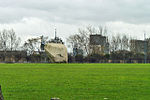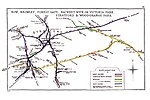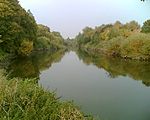Hackney Cut
Buildings and structures in the London Borough of HackneyCanals opened in 1769Geography of the London Borough of HackneyHarv and Sfn no-target errorsLee Navigation ... and 1 more
Use British English from June 2015

The Hackney Cut is an artificial channel of the Lee Navigation built in England in 1769 by the River Lea Trustees to straighten and improve the Navigation. It begins at the Middlesex Filter Beds Weir, below Lea Bridge, and is situated in the (modern) London Borough of Hackney. When built it contained two pound locks and a half-lock, but was rebuilt to handle larger barges in the 1850s, and now only Old Ford Lock, which is actually a duplicated pair, remains.
Excerpt from the Wikipedia article Hackney Cut (License: CC BY-SA 3.0, Authors, Images).Hackney Cut
Lee Canal Towpath, London Hackney Wick (London Borough of Hackney)
Geographical coordinates (GPS) Address Nearby Places Show on map
Geographical coordinates (GPS)
| Latitude | Longitude |
|---|---|
| N 51.5501 ° | E -0.0287 ° |
Address
Lee Canal Towpath
Lee Canal Towpath
E9 5HX London, Hackney Wick (London Borough of Hackney)
England, United Kingdom
Open on Google Maps






